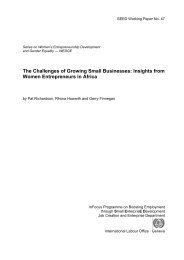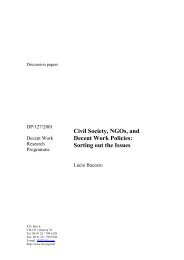manual: women workers' rights and gender equality - International ...
manual: women workers' rights and gender equality - International ...
manual: women workers' rights and gender equality - International ...
You also want an ePaper? Increase the reach of your titles
YUMPU automatically turns print PDFs into web optimized ePapers that Google loves.
story 2:<br />
Kolab, 12 years old, flower garl<strong>and</strong> seller:<br />
Every morning I wake up very early to make the flower garl<strong>and</strong>s I have to sell during the<br />
day. I earn very little money <strong>and</strong> more than half of it I have to pay to the person who brings<br />
the flowers. I try to get a good spot in the city but you have to be early otherwise other kids<br />
already took the busy crossings. Sometimes a friendly person gives you more money. I go<br />
to see a movie sometimes.<br />
Step 3<br />
• Discuss the stories using the following questions:<br />
- Is the work Châk <strong>and</strong> Kolab are doing child labour?<br />
- Why or why not?<br />
- What other forms of child labour can participants think of?<br />
- Do they know what the effects of child labour are?<br />
- Is there child labour in their community?<br />
- In which sectors?<br />
- Can they think of a way to solve this problem?<br />
- What can they do themselves?<br />
Step 4<br />
• Ask the participants to think of their own children, what are they doing the whole day?<br />
- Do they go to school?<br />
- Is this the same for sons <strong>and</strong> daughters?<br />
- What can they do to give fair changes to both sons <strong>and</strong> daughters?<br />
Step 5<br />
• Summarize the discussion <strong>and</strong> give the effects of child labour on children<br />
Notes for the trainer 4<br />
Child Labour<br />
A definition of child labour is: All work which is harmful to a child’s health <strong>and</strong> development.<br />
The examples used in the exercise are explained as follows:<br />
The work done by Bopha is not necessarily harmful. It does not put her health in danger. It is not<br />
her only activity. She has time to go to school <strong>and</strong> play with her friends. Bopha’s work is not<br />
considered to be child labour. Pidor on the other h<strong>and</strong>, does not get the opportunity to play or to<br />
get basic education because she works the whole day. Pidor’s work is a form of child labour.<br />
The two children in the stories are also engaged in child labour. Both are under the minimum age.<br />
Both are doing work that is harmful to their health <strong>and</strong> development. They do not go to school.<br />
Child labour in Cambodia<br />
One of the fundamental ILO Conventions is no. 182: Worst Forms of Child Labour. This<br />
Convention is about the elimination of the worst forms of child labour. Among the worst forms of<br />
child labour are: all forms of slavery, prostitution or pornography, work which is likely to harm the<br />
health, safety or morals of children <strong>and</strong> illicit activities like trafficking or production of drugs.<br />
Convention 182 is not yet ratified by the Cambodian Government but Convention 138 on minimum<br />
age is.<br />
4 Based on: Child Labour – An Information Kit for Teachers, Educators <strong>and</strong> their Organizations, book 1, ILO, Geneva, 1998.<br />
73

















